Top News
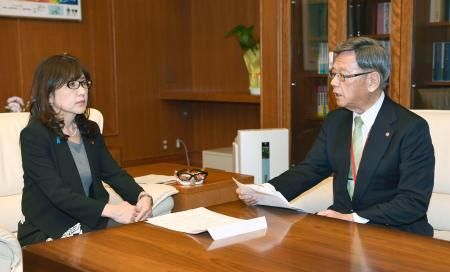
December 16, 2016 Ryukyu Shimpo
After the recent Osprey crash, on December 15, Governor Takeshi Onaga visited Minister of Defense Tomomi Inada at the Ministry of Defense. In his meeting with Inada, Onaga called the Osprey, which has seen continuous problems such as belly landings, a defective aircraft, and said, “Okinawans have strongly opposed the deployment of the Osprey. I cannot contain my anger that it has caused this accident, and I strongly call for an immediate cessation of flights and withdrawal of the aircraft, and strongly protest,” once again demanding that the Osprey deployment be withdrawn. Inada only stated, “We at the Ministry of Defense intend to thoroughly endeavor collect information, make it public, and confirm safety.” Meanwhile, on the same day, Vice Governor Mitsuo Ageda met with Vice Minister of Defense Kenji Wakamiya at the Prefectural Office, and Wakamiya effectively refused the demand that the Osprey be withdrawn. Wakamiya visited Ginowan Mayor Atsushi Sakima in Ginowan and said, “We believe the removal of the dangers posed by U.S. Marine Corps Air Station Futenma is of utmost importance. Therefore, we want to make it our top priority and move the plan forward.” It was the first time a national government official made a comment promoting the Henoko relocation since the Osprey accident.
Onaga requested that the national government cancel the ceremony planned for December 22 in honor of the return of more than half of the U.S. military’s Northern Training Area, which is conditioned on the construction of helipad landing strips (helipads) where the Osprey will train, in light of the accident. Deputy Chief Cabinet Secretary Kazuhiro Sugita, who met with Governor Onaga at the Prime Minister’s Official Residence, denied this request, clearly stating that the government wants to hold the ceremony. After the meeting, Governor Onaga revealed this fact to reporters. Onaga made the same protest to Parliamentary Secretary Kiyoshi Odawara at the Ministry of Foreign Affairs.
Regarding the national government’s response, Governor Onaga said, “It is exactly the same as the government’s methods have always been, but I want them to realize that this time [this accident] is different.”
Meanwhile, Vice Minister of Defense Wakamiya refused the prefectural government’s request for withdrawal of the Osprey in his meeting with Vice Governor Ageda, saying, “In the unstable security environment of East Asia, [the Osprey] is essential.”
After the meeting, Wakamiya expressed to reporters the government’s intention to move forward with the Henoko relocation, saying, “I think that in the sense of increasing safety as well, it is very meaningful. We want to put in our utmost efforts to move the relocation forward as soon as possible.”
In Ginowan, Mayor Sakima said, “The most important thing is the lives of the people of Ginowan and of Okinawa. I want you to think seriously about what should be prioritized from the perspective of the people of Ginowan, who have endured [Futenma] for more than twenty years [since an agreement was made for its closure], and return Futenma as soon as possible.” In response, Wakamiya said, “The Abe administration will work to overcome ministry and agency boundaries and do all we can.”
(English translation by T&CT and Sandi Aritza)
Go to Japanese
December 15, 2016 Ryukyu Shimpo
As long as these dangerous and eerie-grey-colored aircrafts continue to fly, it would be no surprise if they eventually crashed somewhere. It has become all the more clear what needs to be done in order to protect the lives and dignity of Okinawans and to prevent casualties.
This is not limited to the removal of these dangerous aircrafts. It also involves a strong demand to completely remove the U.S. Marine Corps who are stationed in Okinawa that operate these defective aircrafts, and to abandon the construction of the new Henoko base and the Takae helicopter landing strips, or helipads.
On the night of December 13, a Marine Corps vertical takeoff and landing aircraft MV-22 Osprey crash-landed on the coast of Abu in Nago City. Many Okinawans are experiencing a spine-chilling fear and are saying that this was bound to happen.
Indignation toward both Japanese and U.S. governments, which neglect these dangerous trainings while forcing Okinawa to host the Ospreys, is pervading the island where the military bases are located.
Contemptible trivialization
The Japanese and U.S. governments have plans to hold a ceremony for returning most the Northern Training Area (NTA) back to Okinawa on December 22. However, an authoritarian push to speed up the construction of the helipads in Takae of Higashi Village continues to cause strong backlash. Now that the crash-landing has happened on top of that, forcibly going through with the ceremony will only rub Okinawans the wrong way.
Because of this, Governor Takeshi Onaga has requested for the ceremony to be canceled. Despite the imminent return of the NTA, efforts to strengthen the military base’s functions have become conspicuous. The Abe administration’s so-called “decreasing the burden” is just for show. Abe administration’s Chief Cabinet Secretary Yoshihide Suga, who is responsible for “decreasing the burden of hosting the base” should cancel the ceremony.
According to the Marine Corps, the accident was caused by the fuel hose being severed during a midair refueling training and damaging the propeller, resulting in the aircraft becoming unstable. It crashed because it could no longer be controlled. The impact of the crash caused the aircraft to break into pieces, which floated in the ocean. However, rather than calling this a “crash-landing,” the Marine Corps and the Japanese government have insisted that this was an “emergency shallow water landing.” Their efforts to trivialize this matter by trying to suppress the effects of this on the plans for the new Henoko base that Ospreys would be operating at is contemptible.
The cause of the crash-landing also lies in intense training. The frequency of Ospreys taking off and landing at the Takae helipads have increased. Despite protests by people of Ginoza Village and Kin Town, training involving suspending goods midair above residential areas in the middle of the night continues. This infringes on the Noise Reduction Initiatives.
Furthermore, the crash-landing occurred during a midair refueling training when it was dark with high wind speeds. Making skills improvement the top priority, the Marine Corps system that ignores the will of the people by forcing through with dangerous trainings, and a weak sense of human rights is what caused the crash. On the night of the same day, it was revealed that another Osprey had made a belly landing at the Futenma Air Station, which is where the aircraft was deployed.
Safety management by the Marine Corps is not functioning at all. In 2012, 41 heads of municipalities and the chairman signed a petition and opposed the deployment of Ospreys “with all of Okinawa.” That petition is still alive. The Onaga prefectural administration should come up with comprehensive policies for the bases that will lead to the removal of the Marine Corps. The administration should also strengthen its ability to negotiate with the U.S. and Japanese governments.
Offensive remark that looks down on Okinawans
Area Coordinator Nicholson, the top Marine Corps officer in Okinawa, does not understand the emotions of the residents who live where the U.S. forces are stationed. What is going on with this person’s train of thought? It makes one feel as if Okinawa is under U.S. military authority again.
Area Coordinator Nicholson expressed displeasure toward Vice Governor Mitsuo Ageda’s complaint regarding the Osprey crash-landing. He said that the pilot did not cause any damage to houses and residents, that Okinawans should be thankful, and that this act was worthy of a commendation. At one point, he hit the desk and became defiant, questioning whether Vice Governor Ageda was trying to make this into a political issue.
This is when Area Coordinator Nicholson made the offensive remark looking down on Okinawans, showing his colonialist mentality.The attitudes of top officers have adverse effects on the military organization. The Marine Corps has morphed into a foreign object that is completely incompatible with the Okinawan society. They must leave as soon as possible.
This is the second time this year and the 48th time since Okinawa was relinquished to Japan that a U.S. military aircraft has crash-landed in Okinawa. In what other prefecture do U.S. military aircrafts crash more than once a year? Including the prototype stage, Osprey-related crash accidents have occurred one after another, resulting in 37 casualties.
If these defective aircrafts continue to fly, a major accident involving a crash will be unavoidable. Even if every effort is made to ensure safety, this cannot serve as collateral to prevent further casualties. The only way to be completely safe is for them to leave the Okinawan skies.
The U.S. military has not responded to the Japan Coast Guard’s request for a joint inspection. The U.S. military was also seen urging the Okinawa prefectural police to enforce regulation by keeping the press away from the scene. Japan being unable to display their sovereignty during such situations and the faulty Japan-U.S. Status of Forces Agreement must be corrected.
(English translation by T&TC and Chelsea Ashimine)
Go to Japanese
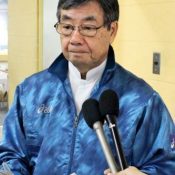
December 14, 2016 Ryukyu Shimpo
On December 14, Nago City Mayor Susumu Inamine spoke to reporters after a U.S. marine MV-22 Osprey crashed into shallow water near Abu in Nago on December 13. He told them, ” The thing that we feared has taken place.”
The mayor said, “It is perfectly clear that citizens will be exposed to a more dangerous environment [if the MV-22s are deployed to a new base planned in Henoko]. They will be placed in a situation where they cannot sleep with peace of mind and their daily lives will be disturbed.”
“The aircraft might have crashed into a village with a difference of a few seconds. Thankfully, due to small mercies, residents were not involved,” said Inamine, adding that there is about 50 meters distance between the crash site and the nearest land.
“This mishap proved that the Osprey was a defective aircraft,” Inamine said. He is blowing a whistle because Osprey mishaps have occurred in many places around the world.
The mayor took a swipe at the central government, saying, “the aircraft was shattered, but they use expressions such as ditch or landing on water in order to disguise the issue.”
(English translation by T&CT)
Go to Japanese
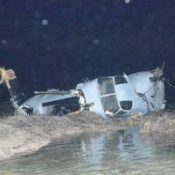
December 14, 2016 Ryukyu Shimpo
An MV-22 Osprey vertical takeoff and landing aircraft belonging to the Futenma base in Ginowan crashed into shallow water off the coast of Abu in Nago City at about 10:00 p.m. on December 13.
The aircraft was shattered.
According to a press release from the U.S. marines stationed on Okinawa, five crewmembers aboard the aircraft were rescued and transported to the U.S. Naval Hospital by an HH-60 helicopter belonging to Kadena Air Base.
Two of the crewmembers have injuries.
The governments of the United States and Japan deployed the Osprey to Okinawa against the opposition of local people in October 2012.
Okinawa Governor Takeshi Onaga has demanded removal of the Osprey. The crash will fuel a backlash from the Okinawan people.
(English translation by T&CT)
Go to Japanese
December 13, 2016 Ryukyu Shimpo
The courts lose any semblance of justice when they trample on democracy and local autonomy. The Supreme Court is about to make a decision that toes the government line and leaves a scar in history.
Okinawa Prefecture is expected to lose the illegality confirmation lawsuit brought by the national government against Okinawa regarding Governor Takeshi Onaga’s rescission of a permit to reclaim from the ocean in Henoko, Nago City. The Second Petty Bench of the Supreme Court will announce their judgement on Okinawa’s appeal on December 20 without listening to any testimony that would have been needed to overturn the initial verdict.
Maintaining equilibrium between the three powers–legislative, administrative, and judicial—is meant to put a check on excessive exercise of power. Can we really allow the court to discard the role it has been tasked with within the system of separation of powers and reaffirm a decision that denies democracy and Okinawa’s self-governance? Such an action invites grave misgivings.
Thrown into a relationship of dominator and dominated
Construction of a new military base in Henoko, Nago City to replace U.S. Marine Corps Air Station Futenma has led to full-on confrontation between Okinawa and the Japanese national government over the issues of local autonomy and the authority of local elected officials.
The revision of the Local Autonomy Law in 1999 gave both national and local governments their own particular authority and put them on equal footing. In this age, local governments build their own arguments to counter those of the national government when it comes to grave issues on which they refuse to back down, and the national government and the courts can no longer ignore these arguments. The Henoko base issue is a perfect example of this.
However, the Naha branch of the Fukuoka High Court made an initial verdict that went against the principle of decentralization of power, and threw the national and prefectural governments back into a relationship of dominator and dominated. Of course, many scholars of administrative law declared it inevitable that the Supreme Court would overturn this decision. The judgement declaring the governor’s decision not to comply with the Minister of Land’s rectification order to be illegal went against the principle of judicial impartiality and merely copied the government’s arguments word for word.
The High Court’s ruling even went so far as to echo the Abe administration’s insistence that “Henoko is the only” possible relocation site for U.S. Marine Corps Air Station Futenma and to repeat the threat that if the Henoko land reclamation were cancelled, “there would be no alternative but for the harm caused by Futenma to continue unabated”.
The verdict also read as follows, presupposing a situation in which all the governors of the forty prefectures in which a U.S. military base could potentially be built on reclaimed land were to refuse such land reclamation: “A decision that cannot be said to be unreasonable by the national government who is in a position in which it must bear the authority and responsibility inherent in defense and diplomacy could be overturned, and a decision by a local public entity could be given priority.”
Such logic dictates that when a national and local government are in conflict regarding issues such as security, the national government is entitled to do whatever it wants without paying any heed to the wishes of the local government. Such logic puts all local governments at risk.
The verdict is full of outrageous logic that ignores public sentiment against the Henoko base, which has been expressed in countless elections, and sides with the Abe administration, which bulldozes forward single-mindedly in its exercise of state power.
We cannot accept the Supreme Court uncritically reaffirming a verdict that paid no mind to Okinawa’s postwar history of suffering under the overwhelming pressure of U.S. bases and contained countless factual errors based on arbitrary assumptions.
Fight back through exercise of available authority
It is expected that after waiting for the verdict on the appeal, the Abe administration will resume construction at Henoko, which had been halted during the trial. It is plain to see that the government will put increased pressure on Governor Onaga and Okinawan public opinion in their eagerness to instill a sense of resignation. Okinawa is facing an even more difficult situation.
However, in view of the civilian sacrifice during the Battle of Okinawa and the accidents and crimes perpetrated by persons affiliated with the U.S. military during the time of U.S. military rule and continuing even after the return to Japan, the legitimacy of Okinawans’ resolute opposition to the new base construction, which contradicts protection of human rights and environmental conservation, will not waver. Resistance will continue to the very end.
Governor Onaga has clearly stated that even after the Supreme Court decision is handed down, he will use every means available to him to prevent the new base construction. Any changes to the design and construction method of the new base will need to be approved by the governor prior to implementation. If Governor Onaga does not approve applications for such changes, the construction will come to a stop each time an application is made.
The Okinawa Defense Bureau still needs to obtain special approval to harvest coral in Oura Bay in order to replant it, and there is a high likelihood that the prefectural government, which says that such harvesting and replanting would have a devastating effect on ecosystems, will not grant such approval. The Nago municipal government also has authority over a number of matters, and there are many elements that will prevent the national government from proceeding with the new base construction at their own free will.
There is one week left before the Supreme Court decision is to be made. Seventy-one years after the end of World War II, and more than twenty years since the agreement was made to return U.S. Marine Corps Air Station Futenma on the condition of relocating it within Okinawa, the power of the people has prevented the reclamation of the Henoko ocean. We must reaffirm that power and sharpen our unyielding spirit to face the trials that await.
(English translation by T&CT and Sandi Aritza)
Go to Japanese
December 12, 2016 Ryukyu Shimpo online edition
In the case the Japanese government has brought against the Okinawa prefectural government regarding Governor Takeshi Onaga’s cancellation of approval to reclaim land in Henoko, the Supreme Court on December 12 set the decision date for December 20. With the decision date set before the arguments have opened in this appeal, the prefectural government’s loss in this case appears to be a foregone conclusion. This is a bleak outcome for the Onaga administration in its efforts to obstruct construction of a replacement facility in Henoko, and will have a significant effect on the dispute from here on out.
Governor Onaga has expressed that he will abide by the court’s final decision, and seems ready to withdraw his cancellation of the landfill permit. This will revive the legal basis for the Japanese government to resume construction work on the new base. However, he is unchanged in his stance to exhaust all methods to obstruct new base construction in Henoko. As such, the outcome of the relocation issue is still uncertain.
During the first trial at the Naha Branch of the Fukuoka High Court, on September 16 the court found Governor Onaga’s cancellation of approval to reclaim land to be illegal, in line with and overall recognizing the claims of the Japanese government. The prefectural government was dissatisfied with the ruling, and appealed on September 23.
(English translation by T&CT and Erin Jones)
Go to Japanese
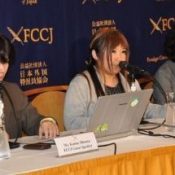
December 8, 2016 Ryukyu Shimpo
(Tokyo) On December 7, more than 100 Diet members, academics, artists, civil society groups and the like submitted an urgent open letter to U.S. President Barack Obama demanding a stop to the construction of helipads in Okinawa with disregard to the environmental burden and the will of the people. The helipads are being built in conjunction with the return of roughly half of the U.S. military’s Northern Training Area, which spans Higashi Village and Kunigami Village. The letter calls for an immediate halt to the construction, stating, “Time is running out for Takae. We request you to make an honorable decision as soon as possible.”
As of December 7, signatories to the letter include film director Isao Takahata, Doshisha University professor Noriko Hama, nonfiction writer Satoshi Kamata, and sociologist Chizuko Ueno.
The idea to submit a letter was proposed by Uchinada Town Councilwoman Hiroko Mizuguchi, 68, of Ichikawa Prefecture. On the 7th, she announced the letter at a press conference at the Foreign Correspondents’ Club of Japan in Tokyo. Uchinada Town was the site of the “Uchinada struggle”, one of the earliest anti-U.S. base construction movements on the Japanese mainland in the 1950s, which led to the closure of a U.S. military firing range. Councilwoman Mizuguchi, who takes part in activities to teach younger generations about the struggle, revealed her reason for wanting to send the letter to President Obama, saying, “Bases became concentrated in Okinawa because of the spread of the anti-base movement [on the mainland]. It was a shock.”
The letter explains that the Japanese government is hurrying to finish the helipads and their process lacks consideration for environmental conservation, pointing out that “Suppression by riot police has therefore become increasingly violent and persistent.” It calls on President Obama, who won the Nobel Peace Prize, saying, “The Japanese government shows little interest in [Okinawans’] plight. As the President of the United States of America, you are now the only person who can save the Takae district in Okinawa.”
Also present at the press conference were Kanna Mitsuta of the international NGO “FoE Japan” and Akino Miyagi, who studies animal and plant life in the Yambaru forests.
(English translation by T&CT and Sandi Aritza)
Go to Japanese
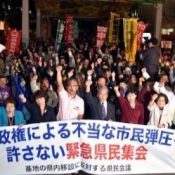
December 9, 2016 Ryukyu Shimpo
Protests against the construction of the new military base in Henoko of Nago City and the construction of a helipad in Takae of Higashi Village have been ongoing. One such protest, namely “The Emergency Rally Against Unjust Civilian Oppressions by the Abe Administration,” which protests against the arrest of people such as Chairman Hiroji Yamashiro of the Okinawa Peace Movement Center, took place at the public square in Naha. More than 500 people participated. Following the rally, participants marched down Kokusai (International) Street and shouted, “It’s an unjust arrest just to serve as an example to others” and “We will not bow down to oppression.”
Okinawa Peace Movement Center Vice Chairman Mio Nakamura, who is also an assemblywoman of the Okinawa Prefectural Assembly, emphasized people’s resolve. She said, “Our resolve, which is the will of the people, will not waver under oppression. The Abe administration has just declared war since it is clear that it is willing to do anything to push forward with the national policy.”
(English translation by T&TC and Chelsea Ashimine)
Go to Japanese
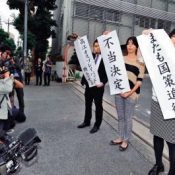
December 7, 2016 Ryukyu Shimpo
In the case 31 Takae residents brought against the Government of Japan concerning helipad construction in the U.S. military’s Northern Training Area (NTA) spanning Higashi and Kunigami Villages, on December 6, the motion for a temporary injunction to suspend construction was denied by the Naha District Court under the presiding judge Kenichi Mori. His reason for the denial was that the residents did not provide enough evidence to convince the court of the illegality of noise and low-frequency sound damage from the helipads after completion.
This is the first judicial ruling made regarding helipad construction itself. Judge Mori pointed out that the Japanese government has taken noise measurements in Takae and identified they are within the estimated noise range from the environmental impact assessment (EIA). Therefore the court acknowledged that the noise is reasonable as specified by the EIA. Since the EIA’s estimated noise levels are lower than environmental quality standards, the court declared it is not possible to say that there is danger of illegal aircraft noise from the helipads.
In regards to Osprey, the noise from takeoff and landing of these aircraft in the N4 Zone falls below the estimated value of the EIA. As such, the court affirmed that even the noise from the takeoff and landing of Osprey is not unreasonable in EIA terms.
Associate Professor Takeshi Tokashiki of the University of the Ryukyus had measurements that showed noise levels exceed environmental quality standards. However, the court found his measurements to be of questionable reliability.
Although the court found there is potential for low-frequency sounds to exceed the EIA’s estimation, it declared that there is not sufficient measurement data to presume that low-frequency sounds are constantly occurring at such intensity. Additionally, the court affirmed that it is inherently difficult to accurately ascertain the degree of harm caused to people’s lives and health by low-frequency waves, and as such it is hard to say whether it is possible for the noise infringe on personal rights and be deemed illegal.
Upon reception of the decision, the Okinawa Defense Bureau (ODB) announced that in order to reduce the base burden reduction on Okinawa it will move forward with the plan to return about 4,000 hectares of the NTA back to Okinawa by the end of the year, and steadily advance construction of the relocation facility. The ODB expects the helipads to be completed by the middle of this month. The ceremony to celebrate the return of the majority of NTA land to Okinawa and the completion of required helipad construction for the return is planned for December 22.
(English translation by T&CT and Erin Jones)
Go to Japanese
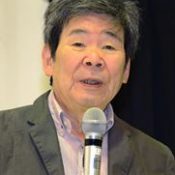
December 6 2016 Ryukyu Shimpo
With the handover of the majority of land occupied by the U.S. military in the Northern Training Area (NTA) in Okinawa set to take place at the end of the month, over 100 people representing 27 groups including members of the Diet, scholars, celebrities, and citizens groups have a signed an emergency open letter to President Obama. The letter is requesting an immediate halt on forced construction in the NTA which continues to be an environmental burden and blatant disregard of public opinion. Advocates for the construction stoppage and the contents of the letter were announced at a Foreign Correspondents’ Club of Japan press conference in Tokyo on December 7.
In addition to House of Representatives member Seiken Akamine and House of Councillors member Keiko Itokazu, anime director Isao Takhata, and journalist and documentary maker Chie Mikami all signed their names to the letter. Advocates for the stoppage are expected to increase hereafter. The letter touches on the Japanese government’s outrageous policies, the situation thrust upon Okinawan residents, and Okinawa’s valuable natural environment.
One representative member, Hitomi Tsuji, noted, “Citizens have to this point made various appeals to the Japanese government, however none of them have yielded a reasonable response.” Additionally, she stressed that, “as the handover date approaches, we are left with no choice but to appeal directly to the President, government, and people of the United States, in hopes that they take interest in the problem as the centrally concerned party.”
(Translated by T&CT and Sam Grieb)
Go to Japanese
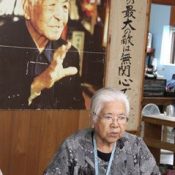
December 5, 2016 Ryukyu Shimpo
By Ayako Sakaguchi
(Iejima) “Henoko, Takae, and Iejima—the three are all one. Anger and frustration continue every day. Even after the passage of 71 years, we are still at war.” On November 22, Etsuko Jahana, 78, director of the Iejima Anti-war Peace Museum, made eye contact with visitors to the museum as she spoke passionately to them.
Jahana’s talk was part of a tour planned by a Tokyo travel agency to learn about the history of Iejima.
She spoke to twelve visitors from both Okinawa and other parts of Japan. Jahana, who long participated in the peace movement with Shoko Ahagon, spoke about the helipad construction being carried out in the U.S. military’s Northern Training Area, which spans Higashi Village and Kunigami Village. “What is this situation, in which Okinawans are fighting with all their might? The central government has taken no responsibility since the Battle of Okinawa, and feels no remorse. It is so frustrating, I just want to ask, what on earth is going on?” Jahana criticized the government’s forceful pursuing of the helipad construction.
Jahana reflected on the Battle of Okinawa 71 years ago and explained the devastating damage experienced by Iejima, saying, “Everything on this island was destroyed. Not a single tree or house was left standing. The enemy was brought to this small island, and corpses became scattered at our feet. The government is the one who brought about that man-made disaster.”
After the war, the islanders of Iejima had their land forcibly seized by the U.S. military. In order to save their land, Ahagon and others engaged in a long fight of nonviolence and peaceful resistance. “Okinawans engaged in sit-ins day and night, 24 hours, even sleeping at the sit-in site,” Jahana explained. “We had many successes. In order to stave off war, many people’s voices are needed. A peace movement can’t be built with only a few people.”
In Iejima, the U.S. Marines’ MV-22 Osprey aircraft fly overhead, and noise issues are increasing. In 2015, the number of times that noise levels above 60 decibels were recorded near Iejima Auxiliary Airfield reached 2.5 times the 2013 figure.
Jahana expressed concern that the Osprey will fly from Iejima to Takae and Henoko and threaten the livelihoods of Yambaru residents. “Okinawans alone can’t bring about peace. All Japanese people are responsible for whether we can overcome the current situation. I want people on the Japanese mainland to be aware,” she said.
(English translation by T&CT and Sandi Aritza)
Go to Japanese








 Webcam(Kokusai Street)
Webcam(Kokusai Street)


